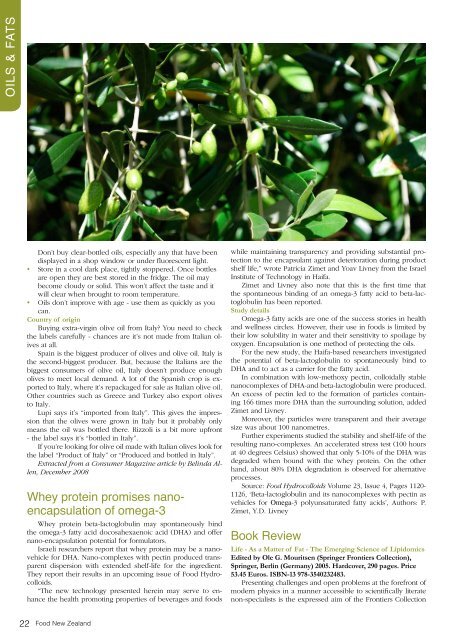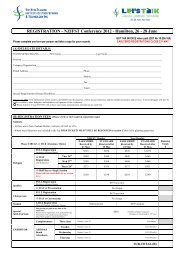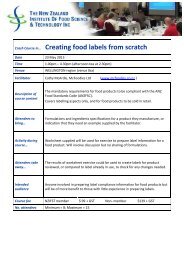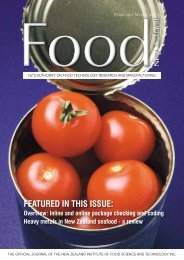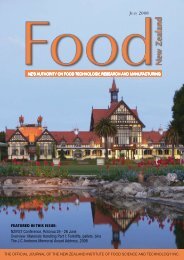featured in this issue - NZIFST - The New Zealand Institute of Food ...
featured in this issue - NZIFST - The New Zealand Institute of Food ...
featured in this issue - NZIFST - The New Zealand Institute of Food ...
Create successful ePaper yourself
Turn your PDF publications into a flip-book with our unique Google optimized e-Paper software.
OILS & FATS<br />
Don’t buy clear-bottled oils, especially any that have been<br />
displayed <strong>in</strong> a shop w<strong>in</strong>dow or under fluorescent light.<br />
• Store <strong>in</strong> a cool dark place, tightly stoppered. Once bottles<br />
are open they are best stored <strong>in</strong> the fridge. <strong>The</strong> oil may<br />
become cloudy or solid. This won’t affect the taste and it<br />
will clear when brought to room temperature.<br />
• Oils don’t improve with age - use them as quickly as you<br />
can.<br />
Country <strong>of</strong> orig<strong>in</strong><br />
Buy<strong>in</strong>g extra-virg<strong>in</strong> olive oil from Italy You need to check<br />
the labels carefully - chances are it’s not made from Italian olives<br />
at all.<br />
Spa<strong>in</strong> is the biggest producer <strong>of</strong> olives and olive oil. Italy is<br />
the second-biggest producer. But, because the Italians are the<br />
biggest consumers <strong>of</strong> olive oil, Italy doesn’t produce enough<br />
olives to meet local demand. A lot <strong>of</strong> the Spanish crop is exported<br />
to Italy, where it’s repackaged for sale as Italian olive oil.<br />
Other countries such as Greece and Turkey also export olives<br />
to Italy.<br />
Lupi says it’s “imported from Italy”. This gives the impression<br />
that the olives were grown <strong>in</strong> Italy but it probably only<br />
means the oil was bottled there. Rizzoli is a bit more upfront<br />
- the label says it’s “bottled <strong>in</strong> Italy”.<br />
If you’re look<strong>in</strong>g for olive oil made with Italian olives look for<br />
the label “Product <strong>of</strong> Italy” or “Produced and bottled <strong>in</strong> Italy”.<br />
Extracted from a Consumer Magaz<strong>in</strong>e article by Bel<strong>in</strong>da Allen,<br />
December 2008<br />
Whey prote<strong>in</strong> promises nanoencapsulation<br />
<strong>of</strong> omega-3<br />
Whey prote<strong>in</strong> beta-lactoglobul<strong>in</strong> may spontaneously b<strong>in</strong>d<br />
the omega-3 fatty acid docosahexaenoic acid (DHA) and <strong>of</strong>fer<br />
nano-encapsulation potential for formulators.<br />
Israeli researchers report that whey prote<strong>in</strong> may be a nanovehicle<br />
for DHA. Nano-complexes with pect<strong>in</strong> produced transparent<br />
dispersion with extended shelf-life for the <strong>in</strong>gredient.<br />
<strong>The</strong>y report their results <strong>in</strong> an upcom<strong>in</strong>g <strong>issue</strong> <strong>of</strong> <strong>Food</strong> Hydrocolloids.<br />
“<strong>The</strong> new technology presented here<strong>in</strong> may serve to enhance<br />
the health promot<strong>in</strong>g properties <strong>of</strong> beverages and foods<br />
while ma<strong>in</strong>ta<strong>in</strong><strong>in</strong>g transparency and provid<strong>in</strong>g substantial protection<br />
to the encapsulant aga<strong>in</strong>st deterioration dur<strong>in</strong>g product<br />
shelf life,” wrote Patricia Zimet and Yoav Livney from the Israel<br />
<strong>Institute</strong> <strong>of</strong> Technology <strong>in</strong> Haifa.<br />
Zimet and Livney also note that <strong>this</strong> is the first time that<br />
the spontaneous b<strong>in</strong>d<strong>in</strong>g <strong>of</strong> an omega-3 fatty acid to beta-lactoglobul<strong>in</strong><br />
has been reported.<br />
Study details<br />
Omega-3 fatty acids are one <strong>of</strong> the success stories <strong>in</strong> health<br />
and wellness circles. However, their use <strong>in</strong> foods is limited by<br />
their low solubility <strong>in</strong> water and their sensitivity to spoilage by<br />
oxygen. Encapsulation is one method <strong>of</strong> protect<strong>in</strong>g the oils.<br />
For the new study, the Haifa-based researchers <strong>in</strong>vestigated<br />
the potential <strong>of</strong> beta-lactoglobul<strong>in</strong> to spontaneously b<strong>in</strong>d to<br />
DHA and to act as a carrier for the fatty acid.<br />
In comb<strong>in</strong>ation with low-methoxy pect<strong>in</strong>, colloidally stable<br />
nanocomplexes <strong>of</strong> DHA-and beta-lactoglobul<strong>in</strong> were produced.<br />
An excess <strong>of</strong> pect<strong>in</strong> led to the formation <strong>of</strong> particles conta<strong>in</strong><strong>in</strong>g<br />
166 times more DHA than the surround<strong>in</strong>g solution, added<br />
Zimet and Livney.<br />
Moreover, the particles were transparent and their average<br />
size was about 100 nanometres.<br />
Further experiments studied the stability and shelf-life <strong>of</strong> the<br />
result<strong>in</strong>g nano-complexes. An accelerated stress test (100 hours<br />
at 40 degrees Celsius) showed that only 5-10% <strong>of</strong> the DHA was<br />
degraded when bound with the whey prote<strong>in</strong>. On the other<br />
hand, about 80% DHA degradation is observed for alternative<br />
processes.<br />
Source: <strong>Food</strong> Hydrocolloids Volume 23, Issue 4, Pages 1120-<br />
1126, ‘Beta-lactoglobul<strong>in</strong> and its nanocomplexes with pect<strong>in</strong> as<br />
vehicles for Omega-3 polyunsaturated fatty acids’, Authors: P.<br />
Zimet, Y.D. Livney<br />
Book Review<br />
Life - As a Matter <strong>of</strong> Fat - <strong>The</strong> Emerg<strong>in</strong>g Science <strong>of</strong> Lipidomics<br />
Edited by Ole G. Mouritsen (Spr<strong>in</strong>ger Frontiers Collection),<br />
Spr<strong>in</strong>ger, Berl<strong>in</strong> (Germany) 2005. Hardcover, 290 pages. Price<br />
53.45 Euros. ISBN-13 978-3540232483.<br />
Present<strong>in</strong>g challenges and open problems at the forefront <strong>of</strong><br />
modern physics <strong>in</strong> a manner accessible to scientifically literate<br />
non-specialists is the expressed aim <strong>of</strong> the Frontiers Collection<br />
22<br />
<strong>Food</strong> <strong>New</strong> <strong>Zealand</strong>


